It is widely assumed that a free press should report accurate and relevant information to the population, and act as ‘watchdog’ of power in the name of public interest. The reporting of secret government surveillance programs leaked by Edward Snowden rekindled a debate in the U.S. concerning the role of the free press, and the boundaries of freedom that journalists ought to respect. Some commentators and government officials were occupied with the possibility of the press taking its watchdog role too far, revealing information that harms national security. (A scenario that so far remains hypothetical.) Would journalists, then, be accomplices to a crime? The converse scenario, by contrast, is rarely raised: Should the press be considered an accomplice to a government crime for withholding information that, if revealed, would change public opinion of criminal government policies – perhaps leading to policy reform?
This second transgression of a free press is by far the more realistic and common. The Israeli press coverage of ‘Protective Edge’, Israel’s latest war on Gaza, is an instructive case study. During the operation, the Israeli mainstream press has been leading a campaign of ignorance, shielding the Israeli public from the facts on the ground and the operation’s devastating consequences for Gaza civilians. When Palestinian suffering does make a scarce appearance in the mainstream press pages, it is understated, distorted or negated. While Palestinians are regularly dehumanized in press coverage, special efforts are made to maintain the morale of the Israeli population, and their commitment to the ongoing military operations.
At the time of writing, over 1,800 Palestinians have been killed in Protective Edge, most of them civilians, and thousands injured. Entire families and neighborhoods have been obliterated. Roughly 500,000 Palestinians have been displaced and forced to flee in search of safe haven in a region where, by UN estimates, none exists. Civilian infrastructure – schools, hospitals, sewage systems, energy sources – has been demolished, now spawning a humanitarian crisis whose scope and long-term effects cannot yet be conceived.
An UNRWA statement reiterates that “Palestinians are not statistics”, that “Behind the figures lie multiple individual destinies now torn apart.” Any elementary survey of the Israeli press’s operation would reveal that it cannot be held to such a nuanced standard, as it often denies Palestinian suffering even the crudest of mentions as statistics. Through omissions, distortions, and diversions, the Israeli press has effectively sheltered its readers from a harsh reality in Gaza.
The Israeli printed press is dominated by two newspapers. The bulk of Israeli Jewish news readers are split between Israel Hayom or Yedioth Aharonoth (which has a proxy website, YNet), the two leading daily newspapers. Of these news readers, 39% read Israel Hayom and 38% read Yedioth Aharonoth. The more internationally known Haaretz newspaper is marginal in Israel by comparison, holding only 5% of readership as of July 2014, a decrease from its 2012 readership of 7%. Haaretz’s popularity with U.S. commentators and in international circles owes in part to the newspaper being an early adopter of digital media, offering full English translations of its articles. International readers often overestimate Haaretz’s influence in mainstream Israeli society for these reasons. The newspaper Maariv, historically one of the more widely read newspapers, declined dramatically in recent years, likely due to the rise of Israel Hayom. Makor Rishon is the most popular newspaper with religious nationalist Jews, while American Jews living in Israel tend to read the English language newspaper The Jerusalem Post or the news site Times of Israel.
The mainstream Israeli press is unapologetically nationalistic. It aligns itself strongly with the IDF and the government’s official national security agenda. Its mode of analysis is a militaristic one, relying on an industry of ‘security’ experts from the defense and military sectors for commentary. The most popular newspapers, Israel Hayom and Yedioth Aharonoth, are subservient to a rhetoric of patriotism and “unity” – where “unity” means united in support of the IDF, and by extension, the ongoing government policy of war.
There has been a series of highly visible instances of civilian devastation in Gaza, inflicted by Israel, whose reporting can be used as a benchmark for analyzing Israeli press coverage. These include the repeated bombings of civilian facilities (like schools, hospitals and mosques), the displacement of hundreds of thousands of Palestinian, the widely covered killing of four boys on a beach in Gaza, and a range of massacres in Gazan cities and neighborhoods. These atrocities make up only a part of the story of the assault on Gaza, but these received extensive coverage in the international press. How are such atrocities reported in the Israeli press, if at all? Who is portrayed as aggressor, and who is victim? When is harm done to Palestinians considered a civilian harm, rather than an achievement of military combat? Which news items make it to the front pages, and which get buried mentions? And how is Palestinian suffering presented compared with Israeli suffering?
To grasp the picture of Gaza that is conveyed in the Israeli press, it is essential to look at the visual context in which the information is presented to readers. Israeli society is accustomed to a bold image of war in the media, which is portrayed in the Israeli press from the one-sided lens of IDF military operations. Israelis are also habituated to the image of war’s aftermath, to families who mourn the death of Israeli soldiers, and to the national commemoration and remembrance ceremonies that follow. For these reasons – and since public opinion of war is heavily swayed by the image of war presented in the press – it is crucial to look at the Israeli press’s use of images.
The Invisible Palestinians
A basic survey reveals that reporting about Palestinian suffering (or Palestinian civilian life generally) rarely makes the front pages or main news headlines in mainstream Israeli newspapers, even in the form of statistics. During the period of Protective Edge (July 7-August 6, 2014), in the pages of Israel Hayom and Yedioth Aharonoth, the Palestinians were invisible.
In this near month long period, the Palestinian death toll appeared only twice on the front pages of Yedioth Aharonoth and three times in Israel Hayom. The Israeli death toll, on the other hand, made the front page nearly every day since the first Israeli was killed on July 16, 2014 (13 front page mentions in Israel Hayom, 14 in Yedioth Aharonoth). Similarly, mentions or images of Palestinian suffering, or damages to Palestinian property, were virtually never shown in Israel Hayom or Yedioth Aharonoth. Incidents of Israeli suffering (e.g. Israeli civilians seeking shelter during early warning sirens) or damages to Israeli property by rockets, however, were featured prominently. In the period surveyed, nearly 80% of the front pages of Israel Hayom featured Israeli suffering, and 81% of Yedioth Aharonoth’s did so.
In contrast to the two most popular newspapers, Haaretz mentioned the Palestinian death toll on its front page nearly every day of the operation (22 out of 27 front pages). Haaretz featured images of Palestinian civilian damages and suffering (frequently alongside suffering and damages on the Israeli side), unlike Yedioth Aharonoth and Israel Hayom. Like Yedioth Aharonoth and Israel Hayom, Haaretz reported the Israeli death toll nearly every day since the onset of the ground invasion.
| News item | Israel Hayom | Yedioth Aharonoth | Haaretz |
| Palestinian death toll | 3/27 | 2/26 | 22/27 |
| Israeli death toll (since 7/16/14) | 13/19 | 14/19 | 13/19 |
| Palestinian suffering | 3/27 | 4/26 | 15/27 |
| Israeli suffering | 21/27 | 21/26 | 17/27 |
| Images of IDF | 24/27 | 20/26 | 10/27 |
Table 1: Frequencies of front page mentions of news items in Israel Hayom, Yedioth Aharonoth and Haaretz. Numerator (bold) indicates the number of mentions, denominator indicates the number of pages analyzed.
The absence of reporting on Palestinian casualties is not surprising – Israel Hayom even justified it explicitly. On August 8, it ran an approving interview with Israeli philosopher Asa Kasher, author of the IDF ethical conduct code and winner of Israel’s highest civil honor, the Israel Prize. Kasher argued that the number of Palestinian casualties is irrelevant, and need not enter into our evaluation of whether IDF operations were moral. According to Kasher, any criticism of IDF tactics in war time amounts to “backstabbing”, and must be avoided as it may disturb the soldiers in battle. Kasher also claimed that the Al-Jazeera network should not be allowed to broadcast from Israel, arguing it has “no place in a democracy” as it serves the propaganda needs of Hamas terror. (Israel Hayom published an abridged English translation of the interview). The celebrated philosopher’s position captures precisely the principles behind the coverage of Israel Hayom and Yedioth Aharonoth.
In the absence of Palestinians, the dominant image portrayed by Israel Hayom and Yedioth Aharonoth is a militaristic one, featuring IDF military achievements or mourning the death of soldiers. The majority of front pages (over 80%) for both newspapers featured images of IDF soldiers or equipment, in or gearing up to battle. About half of the front pages featured mourning of Israeli soldiers, using pictures of military funerals or soldiers’ families. This narrow coverage of war from a military perspective keeps readers focused on the tactical battles between IDF and Hamas, and only elusively hints at the existence of Palestinian civilians in Gaza.
| Image depicting | No. images |
| Palestinian suffering | 24/167 |
| Israeli suffering | 47/167 |
| IDF | 81/167 |
Table 2: Frequencies of types of images in YNet’s collection of 167 “best and most interesting” photos from Protective Edge.
Yedioth Aharonoth’s proxy website, YNet, generally follows the same pattern of nationalistic reporting as Yedioth Aharonoth. YNet features a collection of the “best and most interesting” photographs from Protective Edge operation (see archive with translated captions). The collection, a description of Protective Edge in images, reveals some of the broader political assumptions of the coverage. Of these 167 images, nearly 50% (81 photos) are photographs of IDF soldiers or IDF military equipment, many of them produced by the IDF spokeperson’s office. Only 14% of the photographs show any sort of Palestinian suffering, compared with double the number (28%) which depict Israeli suffering. There are 14 images depicting Palestinian violence or use of force by civilians (e.g. in protests) or militants, but zero that depict Israeli Jews using force, in spite of the recognized wave of violent right-wing nationalist street protests around Israel (where the “Death to Arabs” chant and violence are common). Only one of these 167 photos shows any kind of ‘virtuous’ act by Palestinians, while 13 of the set depict Israeli virtues such as kindness and compassion.
Depictions of Palestinian suffering and damages
We may gain insight into the logic of the mainstream Israeli press by examining rare cases where Palestinian suffering is reported, but must remember that we are analyzing anomalies. In the rare cases when Palestinian suffering is mentioned, it is invariably negated with the usual devices of propaganda. For instance, depictions of Palestinian civilian suffering may be surrounded by far more elaborate illustrations of Israeli suffering, or images of Palestinian terror. The coverage is peppered with reports of Israeli virtues, such as hospital visits by civilians to injured IDF soldiers or public support of mourning families, which may be presented alongside images of Palestinian violence. This pattern of coverage contributes to the continuous dehumanization of Palestinians in the public eye.
Mosques, or “rubbles,” of terror
The destruction of Palestinian property is frequently framed as military victory. The July 30 bombing of the Al-Sousi mosque in the Shati refugee camp was reported as a military feat by Israel Hayom. An image of the mosque’s collapsed minaret was labeled “Mosques of Terror”, with the caption “Mosque near Gaza city that was bombed by Israeli Air Force. Combat equipment was found inside the prayer halls”, the standard IDF explanation for such attacks, which the newspaper rehearses uncritically. By comparison, YNet (Yedioth Aharonoth’s website) and Haaretz both used the same AFP-sourced photograph of the destroyed mosque. YNet’s caption read, “Rubbles in the Shati refugee camp”. Haaretz’s caption was “A mosque that collapsed in a bombing in Gaza”.
Shelling of schools turned shelters
A defining feature of Protective Edge was the repeated shelling of UN facilities by Israel, including UNRWA schools used to house thousands of displaced Palestinians. The series of school bombings sparked international outrage, and was condemned by leading UN officials.
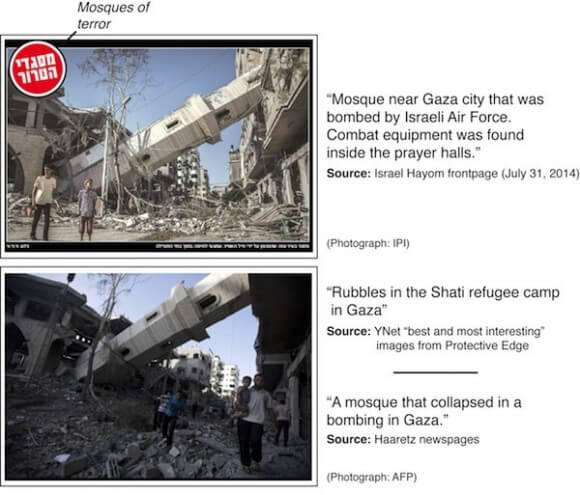
Figure 2: Depictions of the bombing of the Al-Sousi mosque by Israel Hayom, YNet and Haaretz. In these images, Al-Sousi mosque is shown, which was destroyed by Israeli strike on July 30, 2014. The mosque is located at Shati refugee camp.
The July 30 attack on an UNRWA school used as civilian shelter was condemned by UNRWA as “serious violation of international law by Israeli forces.” At that stage, US officials were still not prepared to condemn Israel for the attack, pending an investigation. The subsequent attack on an UNRWA school, on August 3, was condemned by UN Secretary General Ban Ki-moon as “a moral outrage and a criminal act”, and he noted that “Israel Defence Forces have been repeatedly informed of the location of these sites.” The strong statement from the highest ranking UN officials was coupled by a sharp shift by US officials, who also condemned the attack as “disgraceful”, stressing that “Israel must do more to meet its own standards and avoid civilian casualties” and calling for a “full and prompt investigation of the incident”.
The series of attacks on UNRWA schools generally did not make it to the news pages of Israel Hayom and Yedioth Aharonoth. On July 31, Israel Hayom did report the previous day’s bombing of an UNRWA school, though not on its front page. The front page main story was the “Mosques of Terror” story (described earlier) and a report of three Israeli soldiers who, according to IDF, died in a booby-trap in an abandoned “UNRWA health clinic”. The report about the UNRWA school bombing appeared on page 8, titled “Rockets in the school”, with the immediate subheading was “UNRWA admits: for the third time, rockets found in the school”.
Israel Hayom’s report is a mix of fabrications and half-truths taken out of context. The newspaper reports that UNRWA’s Gaza-based spokesperson Adnan Abu Hasna has “accused Israel of intentionally killing civilians”. According to Israel Hayom, Hasna claimed that UNRWA schools where rockets were found were vacant for the summer, and that GPS coordinates of populated schools were given to IDF. However, according to Israel Hayom, UNRWA spokesperson Christopher Gunness gave an account that contradicted Hasna. Israel Hayom reported that Gunness confirmed that this bombing was indeed “the third time that rockets were found in schools” – and that he condemned those responsible as they “risk the lives of innocent civilians as well as the lives of UNRWA workers in the Gaza Strip”.
The agreement attributed to Gunness with Israel Hayom’s account of the events (along with the invented disagreement between Hasna and Gunness) is an outlandish distortion. Gunness has been forcefully condemning the attacks on the UNRWA school, attacks for which Israel is responsible based on all available evidence. In an interview about the July 24 bombing of an UNRWA school in Beit Hanoun, Gunness clarified that “The places [UN facilities] where the weapons caches have been found were schools which had been closed down for the summer…These were not places where refugees had taken shelter.” Gunness added that GPS coordinates were given to IDF and that UNRWA “appealed desperately” to IDF for a humanitarian cease fire to allow evacuation of civilians, but that “no answer came back that was positive. In the end, we could not do that civilian evacuation, and the consequences of that were absolutely tragic. The carnage, the pitiless carnage that you saw on your screens yesterday, was the result.” A statement by UNRWA Secretary General Pierre Krähenbühl on the subsequent July 30 school bombing condemned Israel for the attack, stating that the UN’s own investigation showed “it was Israeli artillery that hit our school, in which 3,300 people had sought refuge”. Israel Hayom’s botched coverage contained no reference to the Secretary General’s statement. (The newspaper published a partial English translation of the article covering the UNRWA school bombing, which contains many of the same false claims as the Hebrew original.)
Israel Hayom is well aware that Gunness’s position, featured extensively in international media, contradicts their own account. The next day, August 1, they ran an opinion piece by Dan Margalit that mocked Gunness for “breaking into tears on television for the Palestinians”, and dismissed Gunness’s claim that Israel attacked the school. Israel Hayom, like the government it serves, is generally defiant of the UN. Scraps of UN statements that can be used to bolster the official state position may be quoted selectively, but in parallel the image of the UN as a hostile and impartial entity must be preserved.
The remainder of the July 31 issue of Israel Hayom, like its other issues from Protective Edge, is best described as an IDF newsletter. It featured full page stories about “a warrior and his lover who cannot be apart for even a moment”, a dog that saved an Israeli soldier in battle, biographies of killed soldiers who wanted to “give their all” to the army, and a news story titled “Warrant of Love: Soldiers who got engaged while on reserve duty”. The Washington Post’s label of Israel Hayom as a “tabloid”, though accurate in terms of the level of reporting, gravely underestimates Israel Hayom’s influence as a daily news source for many Israelis.
Unlike Israel Hayom, Yedioth Aharonoth did not even mention the UNRWA school bombing on its July 31 front page. Their lead story was coverage from a reporter embedded with an IDF brigade that destroyed tunnels in Gaza. The rest of the front page was devoted to mourning of IDF soldiers, and included a story about a soldier’s last meeting with his girlfriend before getting killed.

Figure 3: Yedioth Aharonoth front page (July 31, 2014). UNRWA school bombing and Palestinian death toll are absent. Main features are extensive coverage from a reporter embedded with an IDF unit that eliminates tunnels, and mourning of IDF soldiers killed in battle.
Displaced Gazans and murky Palestinian provenance
Israel Hayom and Yedioth Aharonoth generally gloss over the hundreds of thousands of Palestinians displaced by the Gaza attacks. On July 30, after the number of displaced had grown immensely, YNet’s news page did mention the number of displaced Gazans as the fourth item on its news page. The number was mentioned in a quote attributed to a Gazan resident: “‘More than 200,000 think UN flag will protect them but no safe place in Gaza’, say Strip residents”. When such a statistic concerning Palestinian suffering is mentioned, its source is often attributed to a vague Palestinian entity, such as “Gaza residents”, “Palestinian sources” or “Palestinian factions” – when the same information has been verified by respected international organizations. The number of displaced Gazans, and the observation that there is no safe place in Gaza, were both reported by the UN and human rights groups.

Figure 4: YNet’s news page from July 30, 2014, which references the 200,000 displaced Palestinians in UN schools.
The story that mentioned the number of displaced Gazans was flanked by stories that typify the Israeli press propaganda techniques. The first story was about a Hamas practice run for a terror attack on Israel. The second was a story of IDF bravery and Israeli virtue, describing an Israeli family with multiple members serving in the IDF. The third story was devoted to dehumanizing the Palestinians while vilifying dissent, describing Hamas rocket-shaped cookies that Palestinian are preparing for Eid al-Fitr, and the “pro-Hamas” activists who use social media to turn the world against Israel. The story lamented the propaganda efforts activists who portray the Palestinian narrative by focusing on Palestinian casualties and the horrors of Gaza. It singled out Israeli historian Ilan Pappé as an “ex-Israeli” whose former Israeli identity is used by international media to get away with harsh condemnation of Israel.
The killing of boys on the Gaza beach
The killing of four boys on the Gaza beach was a landmark moment in media coverage of the Gaza war. The New York Times drew sharp criticism for its use of a highly misleading headline for the event. NBC pulled its correspondent Ayman Mohyeldin from Gaza after he witnessed the killing (a decision that was later reversed.) Given the attention this killing received, this event unusually made its way to the front page of Israel Hayom, where it was reported with the headline: “IDF: ‘Killing of children on the beach – a tragedy’” and the subheading, “IDF checks why 4 children were killed in Gaza”. The subheadings of the article covering the story were: “Gaza: The Palestinians claim that 4 children were killed by Israeli naval ship attack. IDF investigates: ‘There is no intention of harming civilians’”.
Yedioth Aharonoth’s coverage followed a similar course. It reported the killing of the boys on its July 17 front page, with the headline “4 Palestinian children killed by IDF fire”, and the subheading “IDF: Tragic error in identification, Hamas makes cynical use of civilians”. A picture of the carried bodies of the boys was juxtaposed by a much larger picture of Israeli kindergarten children ducking on the ground, with the caption: “Children in kindergarten in Hod Hasharon in an unprotected building, during sirens”. This, and the other surrounding stories on the July 17 front page, served to minimize the rare reporting of innocent Palestinian deaths.
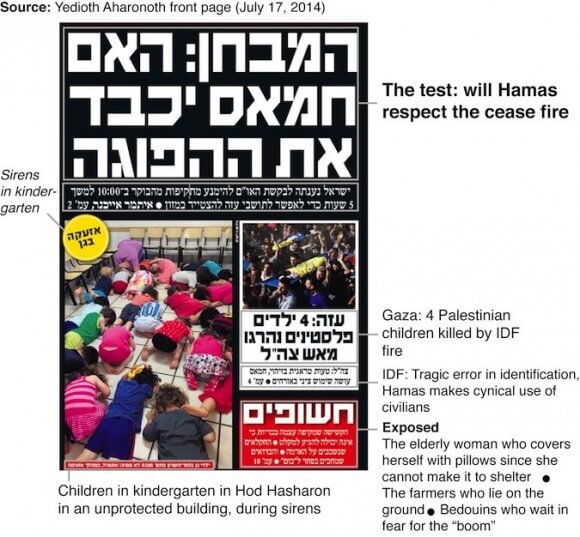
Figure 5: Yedioth Aharonoth’s front page coverage featuring the shooting of boys on the Gaza beach (July 17, 2014).
Understating Palestinian deaths
In the minority of cases when Palestinian suffering makes an appearance, it is nearly universally understated. A rare photo from a Palestinian funeral appears in YNet’s select collection of Protective Edge, with the caption: “Funeral for killed Palestinians in Khan Yunis”.
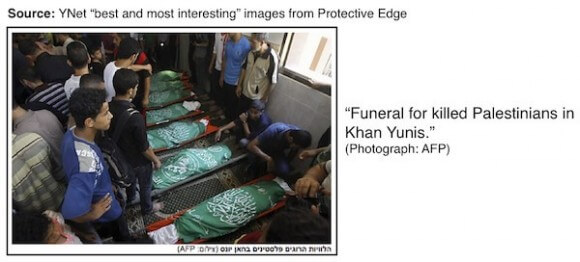
Figure 6: YNet’s depiction of Palestinian funeral. Photograph depicts 8 dead members all of the same family, the al-Hajj family, in Khan Yunis.
The photograph shows the funeral of eight members of the al-Hajj family who were killed by Israeli fire. Photographs from the funeral appeared widely in international press to illustrate the devastation endured by single families. The extinction of many or all members of a single family became commonplace in Protective Edge. This is one of the many personal aspects of devastation of the Palestinian population that fly under the radar of mainstream Israeli press.
Amplifying Israeli suffering and virtue
Apart from their overrepresentation in total numbers in the coverage, instances of Israeli suffering are amplified by other means. In YNet’s “best and most interesting” image collection from Protective Edge, photographs of damages to Israeli property – such as rocket damages to a home in Ashdod – appear in the set multiple times, using distinct photos from the same photographer on the same site. The overrepresentation of these photographs further distorts the basic asymmetry of the conflict: three civilians on the Israeli side have been killed, compared to over a thousand Palestinians. Similarly, a handful of Israeli buildings incurred damages, compared with whole neighborhoods in Gaza that have been wiped off the map.
Yedioth Aharonoth’s July 9 front page provides another significant example of the amplification of Israeli suffering at the expense of reporting on Gaza. The main headline is “Rockets on Israel”, placed on top of a large image of Israeli civilians ducking on the ground during early warning sirens at a Tel-Aviv bus stop. The front page includes no mention of Palestinian destruction and death from Gaza. The other main story is IDF’s killing of Hamas militants, which is reported in Yedioth Aharonoth using images distributed by the IDF spokeperson’s office.
Haaretz used the same photograph as Yedioth Aharonoth of Israeli civilians at the bus stop, and also featured it on the front page. Haaretz juxtaposed the image alongside images of a Gazan family whose home was destroyed, with the caption “Home of Kaware family, after bombing where 8 people were killed, yesterday”. The front page also reported IDF’s killing of Hamas militants, in addition to the number of aerial attacks by Israeli air force on Gaza.
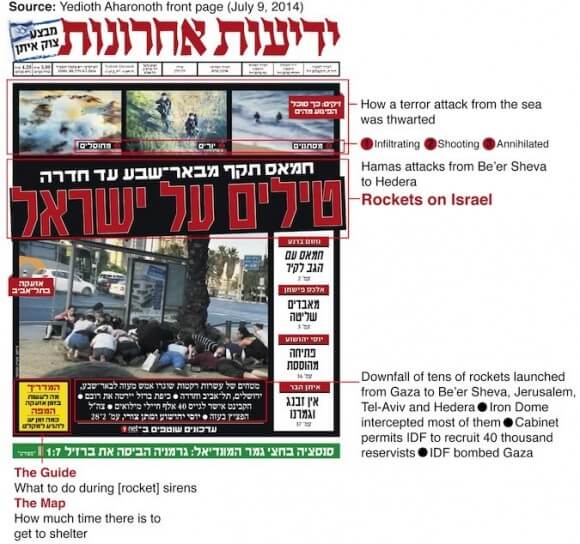
Figure 7: Yedioth Aharonoth front page (July 9, 2014), focused on Israeli rocket attacks and IDF’s operation against Hamas militants (featured using materials from IDF spokesperson’s office.)
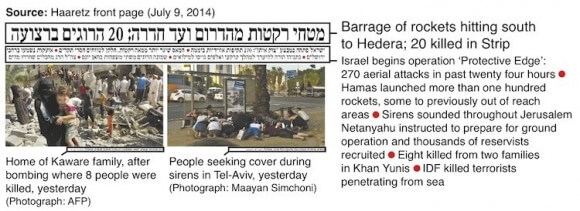
Figure 8: Haaretz front page (July 9, 2014). Image of Israeli civilians at Tel-Aviv bus stop during sirens (right) was also featured on the July 9 front page of Yedioth Aharonoth.
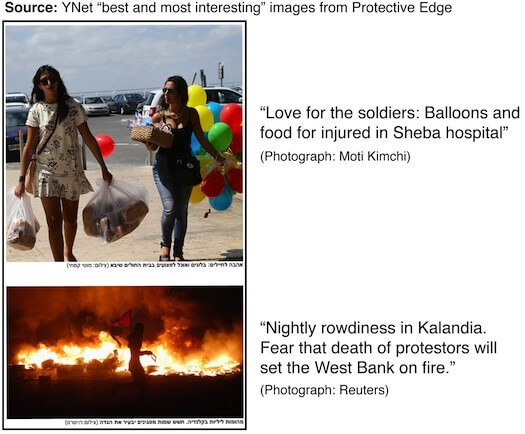
Figure 9: YNet’s depiction of Israeli virtue, juxtaposed with Palestinian violence.
Other efforts are made to amplify Israeli virtues, often by juxtaposing it with images of violence by Palestinians. YNet’s Protective Edge image collection contains an image of Israelis bringing food and balloons to injured IDF soldiers, and events of this sort are sensationalized and reported on extensively in the pages of Israel Hayom and Yedioth Aharonoth. The caption reads: “Love for the soldiers: Balloons and food for injured in Sheba hospital”. Directly below the photograph in the collection is an image of a Palestinian in a protest in the West Bank city of Kalandia against the war on Gaza. In these protests, at least two Palestinians were killed in clashes with police. The caption reads: “Nightly rowdiness in Kalandia. Fear that death of protestors will set the West Bank on fire.”
The day after: Reporting the perceived end of ‘Protective Edge’
In the final days of Protective Edge, after the gravest toll on civilian life and infrastructure had taken place, there was a small but detectable change in Israeli press coverage. The devastation has grown so large and internationally known it had to be reported, even nominally as a buried mention. At this stage, the Palestinian death tolls began to creep in, though with the usual techniques of negation and buried mentions. Some outliers in reporting surfaced, like YNet’s unusual story about the horrors faced in Al-Shifa hospital, which appeared on August 4, two days prior to the initial IDF withdrawal from Gaza. These glimpses of factual reporting are still a negligible minority, drowned out by stories of Israeli suffering and IDF bravery.
The Israeli press’s distorted view of the Gaza war is exemplified by the reporting of Israeli troops exiting from Gaza on August 6, the day believed to be the last of Protective Edge. Israel Hayom led with the front page headline, “And thanks to the soldiers”, in a page that lauded the IDF for its military achievements. Yedioth Aharonoth’s front page was essentially identical in content and emphases, leading with the headline “We salute you”, with the subheading “Senior military official: warriors should be saluted. Generation Y proved they can fight with might no lesser than its predecessors”.

Figure 10: Israel Hayom front page (August 6, 2014). Subheading: “Senior military official: warriors should be saluted. Generation Y proved they can fight with might no lesser than its predecessors”.
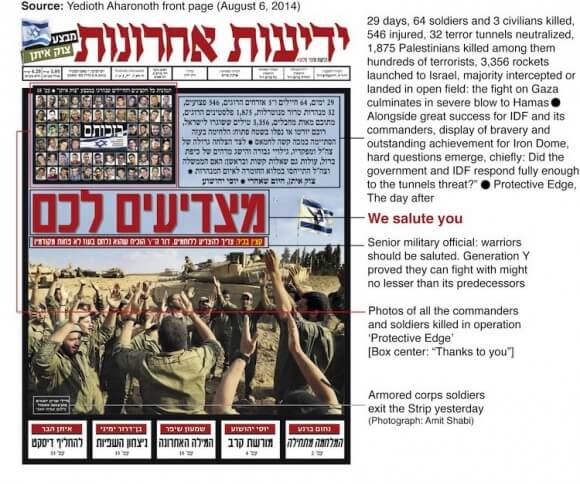
Figure 11: Yedioth Aharonoth front page (August 6, 2014).
It is on the August 6 front page that Yedioth Aharonoth featured the second of its two front page mentions of the Palestinian death toll, in a bullet point summary of Protective Edge:
- “29 days, 64 soldiers and 3 civilians killed, 546 injured, 32 terror tunnels neutralized, 1,875 Palestinians killed among them hundreds of terrorists, 3,356 rockets launched to Israel, majority intercepted or landed in open field: the fight on Gaza culminates in severe blow to Hamas”
- “Alongside great success for IDF and its commanders, display of bravery and outstanding achievement for Iron Dome, hard questions emerge, chiefly: Did the government and IDF respond fully enough to the tunnels threat?”
For Yedioth Aharonoth, the statistic of 1,875 Palestinian casualties is a military feat, not a civilian death toll. The phrase “1,875 Palestinians killed among them hundreds of terrorists” leaves open the theoretical possibility that only few non-terrorists were killed, with IDF living up to its promises of ‘surgical precision’. Israel Hayom avoided the issue of how to favorably present the Palestinian death toll on its front page by omitting it altogether.
Haaretz’s August 6 front page had a more sober headline, “IDF completes withdrawal of its troops from Gaza Strip”. The page featured a story by Amira Haas (a veteran reporter on the Israeli occupation) about the devastation facing Palestinians civilians, titled “Gaza residents return to the ruins that once were their homes”.

Figure 12: Haaretz front page (August 6, 2014).
The function of Israeli press and the propaganda model
The mainstream Israeli press does not aim to report accurate information nor to place checks on power, and it cannot be understood under these assumed goals of a free press. The function of the Israeli press is to faithfully broadcast IDF’s world view, and, when the occasion arises, to orchestrate collective mourning of Israeli casualties. This function achieves two goals. First, it upholds the morale of Israelis in time of war, through stories of military feats and heroism. Second, it keeps the population in check by having them focused on mourning and self-praise – and by equating dissent with a crime against IDF, the holiest of Israeli institutions.
The Israeli press most resembles American media in the initial period following 9/11, where a wave of nationalism swept coverage and silenced dissenting voices. The Israeli media is in constitutive ‘9/11 mode’, on steroids, as can be seen in its treatment of dissidents. Haaretz columnist Gideon Levy, who has been covering the occupied territories for decades, wrote a column criticizing the impersonal and callous destruction of civilians by the Israeli Airforce pilots, sparking great controversy in Israel. Levy has been subsequently harassed on the streets and received enough death threats that the newspaper hired him a bodyguard. Several commentators called for Levy to be tried on charges of ‘inciting’ insubordination of IDF soldiers, while Knesset member Yariv Levin called for him to be tried for treason.
When faced with opposition from dissidents like Levy, the Israeli press assumes the position of an official government interlocutor. In a radio interview with Levy, the radio host started by asking “What is the chemical process that goes on in your head when you write these things?” – as one would have to be mad to question the bombing of civilians by air force pilots. In an interview on Israeli television, after Levy described the violent hostility he was facing, the interviewer suggested Levy keep his criticism of IDF to himself until a later, perhaps calmer time in Israeli society. Unlike in the U.S., where media watch groups can generally draw attention to instances of media distortions, there are no equally visible forums for scrutinizing the Israeli media – especially when such criticisms ring hollow with the overwhelming majority of Israeli Jewish audiences.
The inability of the Israeli press to criticize the government in a time of war is exploited by Israeli leaders. Israeli television’s Channel 2 covered a press conference with Prime Minister Netanyahu on July 11, where Netanyahu described his goal of “restoring peace” to Israeli citizens who are under rocket attack — and vowed to “strike Hamas” until peace is restored. Netanyahu’s main points were not new, and were summarized in Channel 2’s report. What went unreported, and uncontested by journalists in the room, was Netanyahu’s strong rejection of a Palestinian state. In response to a question from a journalist, Netanyahu argued that disengagement from Gaza was a mistake whose consequences are now dealt with by IDF. Netanyahu said that Israel will not, under any condition or agreement, give up “security control” of the area “west of the Jordan river” (i.e., the West Bank). He warned that relinquishing this control would create another front of war, a situation of “twenty Gazas” and “thousands of tunnels” in the West Bank (which he referred to as the biblical “Judea and Samaria”). Netanyahu revealed a simple policy: Israel will not allow Palestinian autonomy in Gaza or the West Bank, much less a Palestinian state, as this would violate Israel’s “security”. The English-language right-wing newspaper Times of Israel, glowing about Netanyahu’s promise to forever occupy the territories, did report this part of the press conference. But the mainstream Israeli press let Netanyahu’s most informative statement escape unnoticed.
Distortions of the Gaza War, and blind rehearsal of Israeli government positions, have been documented in the American press as well. On ‘Face The Nation’, CBS news veteran Bob Schieffer summarized the recent Gaza events by stating that Palestinians “find themselves in the grip of a terrorist group that has embarked on a strategy to get its own children killed in order to build sympathy for its cause, a strategy that might actually be working, at least in some quarters” – regurgitating the unsubstantiated IDF claim that Palestinians are used as human shields by Hamas. He went on to cite former Israeli Prime Minister Golda Meir’s infamous quote, which according to Schieffer, “might have been said yesterday”: “We can forgive the Arabs for killing our children, but we can never forgive them for forcing us to kill their children.” Schieffer is right, though, that Meir’s insights are relevant these days. Her other famous quote, “There are no Palestinian people…No Palestinian refugees”, serves as an accurate summary of the Israeli press coverage of the assault on Gaza.
The ‘propaganda model’, proposed by Edward Herman and Noam Chomsky in their book Manufacturing Consent (1988), explains the behavior of the U.S. media by analyzing the constraints the elite funding sources of the media impose on it. The propaganda model applies broadly to the media in countries where there is a wide range of legal freedom of speech, and Israel is no exception. Under the propaganda model, the “societal purpose” of media in democracies is not to provide citizens with reliable information for voting decisions, nor to keep state power in check. Rather, the media’s purpose is “to inculcate and defend the economic, social, and political agenda of privileged groups that dominate the domestic society and state.” The media fulfill their purpose “through selection of topics, distribution of concerns, framing of issues, filtering of information, emphasis and tone, and by keeping the debate within the bounds of acceptable premises” – all techniques practiced by mainstream Israeli press in Gaza coverage.
A propaganda model explains why Yedioth Aharonoth may criticize Netanyahu’s leadership, within confined bounds, while Israel Hayom cannot. The right-wing American Jewish billionaire Sheldon Adelson is the owner of Israel Hayom and a strong supporter of Netanyahu, which accounts for the lack of criticism of Netanyahu’s government in the paper as well as the overarching political tone. While Yedioth Aharonoth can fiercely criticize Netanyahu’s policies in its opinion pages, this criticism may only be on military and strategic grounds. Some may criticize Netanyahu for not being forceful enough against Hamas, or for not properly equipping the soldiers to carry out the operation. Others may argue that the tunnels in Gaza should have been destroyed long ago, or that the Gaza disengagement plan was a mistake and that military presence should be reinstated inside Gaza. There are other minor differences between Israel Hayom and Yedioth Aharonoth. Yedioth Aharonoth, unlike Israel Hayom, still occasionally allows veteran peaceniks like novelist David Grossman have a dovish opinion piece, giving the appearance that Yedioth Aharonoth is “left” of Israel Hayom. But the differences between Israel Hayom and Yedioth Aharonoth are overall minor.
Haaretz is the only newspaper of the three that provided windows into the situation in Gaza, in a way that resembled international coverage. Haaretz employs journalists who are seasoned experts on the history of the Israeli occupation, and that contribute major reporting on Gaza and the West Bank. The newspaper still falls into the trap of false symmetries, ‘balancing’ Israeli and Palestinian suffering even when the two are radically unequal. Haaretz also still takes on the role of IDF commemoration facilitator, as expected from Israeli press outlets, though much less so than its more popular competitors. It is a testament to the dismal state of Israeli press when the burden of journalism falls on a single newspaper, one whose readership is marginal to begin with.
There are subtle differences in the application of a propaganda model to Israeli media, compared with its American counterpart. Evidence for the propaganda model is most striking when there is a large discrepancy between public opinion and the opinion of media funding elites. In the case of Protective Edge, Israeli Jews were overwhelmingly in support of the government, and so the opinions of elites and the voting public were more or less aligned. Another important factor in the Israeli press’s behavior, beyond the propaganda model, is the Israeli government’s exercise of censorship power. The Israeli government imposes gag orders on information that they deem sensitive for national security. The Israeli press obeys these orders, and waits for them to be lifted prior to reporting, even when the information has already been revealed by international news outlets. The Israeli government also prohibited Israeli journalists from entering Gaza during Protective Edge, apart from the handful of journalists embedded with IDF troops. (It wasn’t until July 23, the 16th day of the operation, that a group of Israeli news outlets filed a joint request to IDF spokesperson to grant them independent entry to Gaza.)
There is an argumentative trap built into the project of dismantling media propaganda, as Herman and Chomsky note. Critical analysis of government or military policy “must meet far higher standards”, and requires one to “work hard, to produce evidence that is credible, to construct serious arguments, to present extensive documentation—all tasks that remain superfluous as long as one remains within the presuppositional framework of the doctrinal consensus.” This is why faithful rehearsal of the IDF spokesperson’s position is considered objective reporting, while criticism or skepticism of IDF claims demands great evidence. The greatest public “victory” such criticism may yield is a delayed admission of error from IDF or government officials, as in the case of white phosphorous use against civilians in Operation Cast Lead. However, the unstated assumptions of the discussion – that it’s permissible to kill an unbounded number of Palestinians for the low probability of assassinating a state-marked terrorist, that IDF is a humanitarian army that operates with high-tech ‘surgical precision’, and that failure to minimize civilian harm is always an unintended and regrettable tactical error on the part of Israel – remain in place.
The Israeli press’s coverage of Gaza is a clear demonstration of a press transgression against its population. There is no doubt that the press holds some power to shift public opinion, even if in small increments. It is by now a foregone conclusion that the Israeli press will take on the role of national orchestrator of mourning when there are Israeli deaths, leaving little room for anything else. Yet even in the early phases of the operation – where there were literally zero Israeli casualties – the press omitted and distorted, leaving its readers ignorant. Israel’s mainstream media acted as a highly effective ‘iron dome’ on behalf of the government and the IDF, sparing Israeli citizens uncomfortable truths of the atrocities committed on their behalf.
The gravest images of Palestinian suffering will not be shown in the most popular newspapers in Israel. The stories of loss and devastation, of individuals and families, will not be told. The unfolding humanitarian crisis and its consequences for innocent civilians will not be elaborated for Israeli readers. The fate of the thousands of displaced Palestinians, for whom displacement is a familiar occurrence, won’t be followed. For the displaced, a new story of devastation and endless rebuilding is now only beginning. Meanwhile, in the opinion pages of Israeli press, there is already talk of the next war.
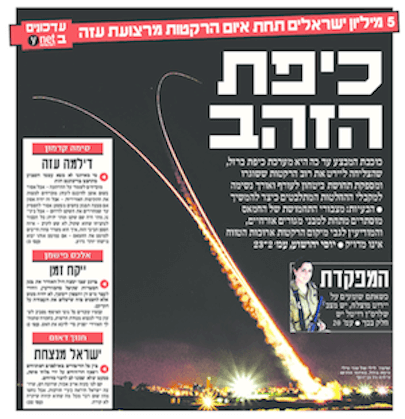


The garden variety pro-Israel troll will reflexively dismiss most, if not all, of the Palestinian civilian casualties as the result of ‘human shields’.
Then there’s the street theater caliber bullshitting with regards to the rockets.
Rockets which have killed 8 people in 13 years? Something like that.
How many thousands of Palestinians have died in the same time frame?
The Zionists also emphasize the sheer number of rockets fired, but Israel has fired far more munitions anyways.
In every single facet, Israel is the aggressor and commits far more crimes.
It takes an entire industry and a coordinated global effort to spread pro-Israel views.
An extremely important and valuable post. Thanks to Yarden Katz for his work.
RE: “The Israeli press coverage of ‘Protective Edge’, Israel’s latest war on Gaza, is an instructive case study. During the operation, the Israeli mainstream press has been leading a campaign of ignorance, shielding the Israeli public from the facts on the ground and the operation’s devastating consequences for Gaza civilians.” ~ Yarden Katz
URI AVNERY ON THE SORRY STATE OF THE ISRAELI MEDIA/PRESS, AND HOW THE ISRAELIS HAVE BEEN “BRAINWASHED”:
“Israel’s Weird Elections”, by Uri Avnery, Counterpunch, 1/04/13:
ENTIRE COMMENTARY – http://www.counterpunch.org/2013/01/04/israels-weird-elections/
Super analysis
But press propaganda can only get 95% approval if the population has been “seasoned” via the education system
http://www.haaretz.com/news/features/.premium-1.611822
” There is no discussion about the topic of racism in the school and there probably will not be,” the principal admits. “We are not prepared for the deep, long-term process that’s necessary. Even though I am constantly aware of the problem, it is far from being dealt with. It stems in the first place from the home, the community and the society, and it’s hard for us to cope with it. You have to remember that another reason it’s hard to deal with the problem is that it also exists among the teachers. Issues such as ‘human dignity’ or ‘humanism’ are in any case considered left-wing, and anyone who addresses them is considered tainted.”
Threat of noise
Prof. Yoram Harpaz is a senior lecturer at Beit Berl Teachers College and the editor of Hed Hahinuch, a major educational journal. Recalling the recent promise of Education Minister Shay Piron that classes in the first two weeks of the coming school year will be devoted to “emotional and social aspects of the summer’s events,” including “manifestations of racism and incitement,” Harpaz observes that schools in their present format “are incapable of dealing with the racist personality and identity.”
He adds: “The schools are not geared for this. They can only impart basic knowledge and skills, hold examinations on them and grade the students. In fact, they have a hard time doing even that. In classes of 40 students, with a strict curriculum and exams that have to be held, it is impossible to engage in values-based education.”
Yaron, a senior lecturer in sociology at Ashkelon Academic College, emphasizes how important teachers and the principal (and the education system in general) feel it is to stick to the curriculum and the lessons schedule – two islands of quiet amid a risk-laden reality.
“Doing this makes it possible for the teachers not to enter a dynamic sphere, which obligates openness and is liable to open a Pandora’s box, too,” he notes. “The greatest threat to the teacher is that there will be noise – that someone will complain, that an argument will break out, etc. That danger looms especially large in subjects that interest young people, such as sexuality, ethnicity, violence and racism. Teachers lack the tools to cope with these issues, so they are outsourced, which only emasculates educational personnel even more.”
The demand for quiet in the schools is not only an instrumental matter, deriving from the difficulty of keeping order in the classroom. There is also an ideological aspect involved. In general, there is a whole series of subjects that are not recommended for discussion in schools, such as the Nakba (or “catastrophe,” the term used by Palestinians to denote the establishment of the State of Israel), human rights and the morality of Israeli army operations. This was one of the reasons for the warnings issued by Tel Aviv University and Ben-Gurion University of the Negev during the fighting in the Gaza Strip about “extreme and offensive remarks.”
Harpaz: “In Israel, the most political country there is, political education has not been developed as a discipline in which high-school students are taught how to think critically about political attitudes, or the fact that those attitudes are always dependent on a particular viewpoint and on vested interests.”
What, then, can be done? According to Harpaz, the solution will not be found in discussions between the homeroom teacher and the students. Nor is a condemnation, however late, by the education minister sufficient. A more radical change is needed.
“Values and outlooks are acquired in a lengthy process of identification with ‘significant others,’ such as teachers,” Harpaz explains. “This means that every aspect of the schools – patterns of teaching, evaluation methods, curricula, the physical structure and the cultural climate – has to change in the direction of becoming far more dialogical and democratic.”
And he has one more recommendation: not to flee from political and moral dilemmas, or from possible criticism. “Our leaders are so fearful of criticism, but they don’t understand that critical education is what generates close ties and caring. We get angry at those we love.”
And G-d didn’t design Israel’s education system. Right wing Zionists did. It’s a feeder for the IDF. And the IDF can’t run the occupation like it used to. System crisis.
American Jews of the same age do not grow up in the same system of hate and narcissism.
Also how are those Israeli kids supposed to compete internationally ?
RE: “While Palestinians are regularly dehumanized in press coverage, special efforts are made to maintain the morale of the Israeli population, and their commitment to the ongoing military operations.”~ Yarden Katz
MY COMMENT: Maintaining the morale of the Israeli population, and their commitment to ongoing military operations (especially a “good wholesome war”) is something that the Israeli press/media apparently excel at.*
* SEE: “Israel’s Trauma Psychology and the Attack on Gaza”, By Avigail Abarbanel, Sunday 4th January 2009
SOURCE – http://www.avigailabarbanel.me.uk/gaza-2009-01-04.html
● AVIGAIL ABARBANEL’S SITE – http://www.avigailabarbanel.me.uk/